Influence of Composite Amendments on the Characteristics of Sandy Soil
Abstract
1. Introduction
2. Materials and Methods
2.1. Study Site
2.2. Pot Experiment Design
2.3. Preparation of Composite Amendments
2.4. Soil and Plant Property Analysis
2.5. Statistical Analysis
3. Results
3.1. Effect of Composite Amendments on Soil Properties
3.1.1. pH, EC, and SMC of Soil
3.1.2. SOC, N, and P Content of Soil
3.2. Effect of Composite Amendments on L. perenne Growth
3.2.1. L. perenne Biomass
3.2.2. L. perenne Height
3.2.3. N and P Content of L. perenne
4. Discussion
4.1. Characteristics of Soil pH and EC and SMC
4.2. Changes in SOC Content
4.3. Changes in Soil Nutrient Content
4.4. Changes in L. perenne Growth Indicators
4.5. Prospects
- (1)
- Field trials will be conducted to further validate the adaptability of the amendments and their effects under various climatic conditions.
- (2)
- Molecular biology, microbiome analysis, and isotope tracing techniques will be used to better understand the mechanisms by which composite amendments influence soil quality and vegetation restoration.
- (3)
- Life cycle assessment methods will be applied to evaluate the cost-effectiveness of the amendments and explore more cost-effective, sustainable formulations for broader agricultural applications.
5. Conclusions
- (1)
- Composite amendments improved soil pH, increased EC, and enhanced SMC. The pH of amended sandy soil remained consistently within a neutral range of 7.0–7.5, which was more favorable for plant growth. The addition of composite amendments led to an increase in soil EC, which further decreased with the cultivation of L. perenne. After two cycles of planting, SMC increased from 5.59% and 5.65% to 7.95% and 6.86% (p < 0.05) in the treatments with 4.5% and 6% amendment additions, respectively.
- (2)
- The composite amendments significantly enhanced SOC and nutrient content. Under L. perenne cultivation, the OC content in amended sandy soil increased by approximately 1–4 times compared to the unamended soil. In the treatment with 3% amendment, the increases in TN and TP were the highest, with TN rising from 0.74 to 1.83 g·kg−1 (p < 0.05) and TP increasing from 0.52 to 0.58 g·kg−1.
- (3)
- Appropriate application of composite amendments effectively improved L. perenne plant height, dry weight, and nitrogen and phosphorus content. Under different amendment rates, L. perenne height in the second planting cycle was approximately 10 cm higher than in the first cycle. At the 3% amendment level, L. perenne dry weight was consistently high across both planting cycles, with nitrogen and phosphorus content showing minimal differences compared to the higher 4.5% and 6% amendment treatment groups.
- (4)
- Considering the changes in pH, EC, SMC, SOC, TN, and TP, the 3% amendment level was identified as the optimal rate for improving sandy soil and supporting L. perenne growth. To further enhance soil improvement effects, it is recommended to reduce the salt content in the biochar used in the amendments.
Author Contributions
Funding
Institutional Review Board Statement
Informed Consent Statement
Data Availability Statement
Acknowledgments
Conflicts of Interest
Abbreviations
| SOC | Soil organic carbon |
| EC | Electrical conductivity |
| SMC | Soil moisture content |
| SOM | Soil organic matter |
| OC | Organic carbon |
| TN | Total nitrogen |
| SSA | Specific surface area |
| TP | Total phosphorus |
References
- Sylvain, B.; Mikael, M.H.; Florie, M.; Emmanuel, J.; Marilyne, S.; Sylvain, B.; Domenico, M. Phytostabilization of As, Sb and Pb by two willow species (S. viminalis and S. purpurea) on former mine technosols. CATENA 2016, 136, 44–52. [Google Scholar] [CrossRef]
- Pan, H.; Liang, J.; Zhao, Y.; Li, F. Facing the 3rd national land survey (cultivated land quality): Soil survey application for soil texture detection based on the high-definition field soil images by using perceptual hashing algorithm (pHash). J. Soils Sediments 2020, 20, 3427–3441. [Google Scholar] [CrossRef]
- Liu, B.; Cai, Z.; Zhang, Y.; Liu, G.; Luo, X.; Zheng, H. Comparison of efficacies of peanut shell biochar and biochar-based compost on two leafy vegetable productivity in an infertile land. Chemosphere 2019, 224, 151–161. [Google Scholar] [CrossRef] [PubMed]
- Li, L.; Pan, F.; Tian, X.; Li, Y.; Rao, L.; Zhao, L.; Wang, Y.; Liao, X. Assessing the influences of β-glucan on highland barley starch: Insights into gelatinization and molecular interactions. Food Chem. 2024, 460, 140767. [Google Scholar] [CrossRef] [PubMed]
- Fan, Y.; Shi, J.; Shi, W.; Nie, W. Soil water infiltration characteristics for drip irrigation of seedlings to reduce aeolian erosion of sandy soils. J. Irrig. Drain. Eng. 2024, 150, 04024033. [Google Scholar] [CrossRef]
- Mishra, S.; Chauhan, G.; Ojha, K. An experimental study on optimizing parameters for sand consolidation with organic-inorganic silicate solutions. Petroleum 2024, 10, 483–493. [Google Scholar] [CrossRef]
- Guo, X.; Yang, G.; Ma, Y.; Qiao, S. Effects of different sand fixation plantations on soil properties in the Hunshandake Sandy Land, Eastern Inner Mongolia, China. Sci. Rep. 2024, 14, 27904. [Google Scholar] [CrossRef]
- Xu, M.; Liu, Y.; Xi, J.; Li, S.; Li, Z. Optimization of soil hydrological properties in degraded grasslands by soil amendments. J. Hydrol. 2024, 643, 131946. [Google Scholar] [CrossRef]
- Zhang, H.; Wang, G.; Du, J.; Pei, X.; Du, P.; Zhou, L. Effects of several polymeric materials on the improvement of the sandy soil under rainfall simulation. J. Environ. Manag. 2023, 345, 118847. [Google Scholar] [CrossRef]
- Sánchez, E.; Zabaleta, R.; Fabani, M.P.; Rodriguez, R.; Mazza, G. Effects of the amendment with almond shell, bio-waste and almond shell-based biochar on the quality of saline-alkali soils. J. Environ. Manag. 2022, 318, 115604. [Google Scholar] [CrossRef]
- Hou, J.; Suo, Q.; Liang, H.; Liu, C. Synergy of organic material on Amlioration of Artemisia Ordosica biochar on sandy soil available nutrients. Soils 2024, 48, 463–467. [Google Scholar] [CrossRef]
- Karbout, N.; Mlih, R.; Latifa, D.; Bol, R.; Moussa, M.; Brahim, N.; Bousnina, H. Farm manure and bentonite clay amendments enhance the date palm morphology and yield. Arab. J. Geosci. 2021, 14, 818. [Google Scholar] [CrossRef]
- Wang, K.; Hou, J.; Zhang, S.; Hu, W.; Yi, G.; Chen, W.; Cheng, L.; Zhang, Q. Preparation of a new biochar-based microbial fertilizer: Nutrient release patterns and synergistic mechanisms to improve soil fertility. Sci. Total Environ. 2023, 860, 160478. [Google Scholar] [CrossRef]
- He, M.; Wu, Y.; Liu, X.; Wu, B.; Fu, H. Constructing a multi-functional small urban green space network for green space equity in urban built-up areas: A case study of Harbin, China. Heliyon 2023, 9, e21671. [Google Scholar] [CrossRef]
- Usharani, K.V.; Roopashree, K.M.; Naik, D. Role of soil physical, chemical and biological properties for soil health improvement and sustainable agriculture. J. Pharmacogn. Phytochem. 2019, 8, 1256–1267. [Google Scholar]
- Brtnicky, M.; Hammerschmiedt, T.; Elbl, J.; Kintl, A.; Skulcova, L.; Radziemska, M.; Latal, O.; Baltazar, T.; Kobzova, E.; Holatko, J. The potential of biochar made from agricultural residues to increase soil fertility and microbial activity: Impacts on soils with varying sand content. Agronomy 2021, 11, 1174. [Google Scholar] [CrossRef]
- Kebede, B.; Tsunekawa, A.; Haregeweyn, N.; Tsubo, M.; Mulualem, T.; Mamedov, A.I.; Meshesha, D.T.; Adgo, E.; Fenta, A.A.; Ebabu, K.; et al. Effect of Polyacrylamide integrated with other soil amendments on runoff and soil loss: Case study from northwest Ethiopia. Int. Soil Water Conserv. Res. 2022, 10, 487–496. [Google Scholar] [CrossRef]
- El-bagory, M.; Shaker, E.M.; El-Nahrawy, S.; Omara, A.E.D.; Khalifa, T.H. The concurrent application of Phosphogypsum and podified biochar as soil amendments influence sandy soil quality and wheat productivity. Plants 2024, 13, 1492. [Google Scholar] [CrossRef]
- Rickson, R.J. Controlling sediment at source: An evaluation of erosion control geotextiles. Earth Surf. Proc. Land 2010, 31, 550–560. [Google Scholar] [CrossRef]
- Ma, Y.; Mongkolthanaruk, W.; Riddech, N. Enhancing soil amendment for salt stress using pretreated rice straw and cellulolytic fungi. Sci. Rep. 2024, 14, 13903. [Google Scholar] [CrossRef]
- Ye, J.; Wang, Y.; Kang, J.; Chen, Y.; Hong, L.; Li, M.; Jia, Y.; Wang, Y.; Jia, X.; Wu, Z.; et al. Effects of long-term use of organic fertilizer with different dosages on soil improvement, nitrogen transformation, tea yield and quality in acidified tea plantations. Plants 2022, 12, 122. [Google Scholar] [CrossRef] [PubMed]
- Banedjschafie, S.; Durner, W. Water retention properties of a sandy soil with superabsorbent polymers as affected by aging and water quality. J. Plant Nutr. Soil Sci. 2015, 178, 798–806. [Google Scholar] [CrossRef]
- Abulaiti, A.; She, D.; Liu, Z.; Sun, X.; Wang, H. Application of biochar and polyacrylamide to revitalize coastal saline soil quality to improve rice growth. Environ. Sci. Pollut. Res. 2022, 30, 18731–18747. [Google Scholar] [CrossRef]
- Mamedov, A.I.; Tsunekawa, A.; Tsubo, M.; Fujimaki, H.; Ekberli, I.; Şeker, C.; Öztürk, H.S.; Cerdà, A.; Levy, G.J. Structure stability of cultivated soils from semi-arid region: Comparing the effects of land use and anionic polyacrylamide application. Agronomy 2020, 10, 2010. [Google Scholar] [CrossRef]
- Lin, M.; Li, F.; Li, X.; Rong, X.; Oh, K. Biochar-clay, biochar-microorganism and biochar-enzyme composites for environmental remediation: A review. Environ. Chem. Lett. 2023, 21, 1837–1862. [Google Scholar] [CrossRef]
- Tian, X.; Zhang, X.; Yang, G.; Wang, Y.; Liu, Q.; Song, J. Effects of microbial fertilizer application on soil ecology in saline–alkali fields. Agronomy 2024, 15, 14. [Google Scholar] [CrossRef]
- Deru, J.; Schilder, H.; van der Schoot, J.R.; van Eekeren, N. Genetic differences in root mass of Lolium perenne varieties under field conditions. Euphytica 2014, 199, 223–232. [Google Scholar] [CrossRef]
- He, M.; Li, Z.; Chen, C.; Mei, P. Impact of soil types and root exudates on cadmium and petroleum hydrocarbon phytoremediation by Sorghum sudanense, Festuca arundinace, and Lolium perenne. Front. Ecol. Evol. 2022, 10, 1036765. [Google Scholar] [CrossRef]
- Li, Z.; Schneider, R.L.; Morreale, S.J.; Xie, Y.; Li, C.; Li, J. Woody organic amendments for retaining soil water, improving soil properties and enhancing plant growth in desertified soils of Ningxia, China. Geoderma 2018, 310, 143–152. [Google Scholar] [CrossRef]
- Liu, Z.; Dai, Y.; Wen, T.; Wei, P.; Fu, Y.; Qiao, M. Study on the effect of magnesium chloride-modified straw waste biochar on acidic soil properties. Molecules 2024, 29, 3268. [Google Scholar] [CrossRef]
- Wyszkowska, J.; Borowik, A.; Kucharski, J. The resistance of Lolium perenne L.× hybridum, Poa pratensis, Festuca rubra, F. arundinacea, Phleum pratense and Dactylis glomerata to soil pollution by diesel oil and petroleum. Plant Soil Environ. 2019, 65, 307–312. [Google Scholar] [CrossRef]
- Kheir, A.M.; Govind, A.; Zoghdan, M.G.; Khalifa, T.H.; Aboelsoud, H.M.; Shabana, M.M. The fusion impact of compost, biochar, and polymer on sandy soil properties and bean productivity. Agronomy 2023, 13, 2544. [Google Scholar] [CrossRef]
- Verheijen, F.G.; Zhuravel, A.; Silva, F.C.; Amaro, A.; Ben-Hur, M.; Keizer, J.J. The influence of biochar particle size and concentration on bulk density and maximum water holding capacity of sandy vs sandy loam soil in a column experiment. Geoderma 2019, 347, 194–202. [Google Scholar] [CrossRef]
- Islam, M.U.; Jiang, F.; Guo, Z.; Peng, X. Does biochar application improve soil aggregation? A meta-analysis. Soil Till. Res. 2021, 209, 104926. [Google Scholar] [CrossRef]
- Ji, G.; Xu, M.; Wen, S.; Wang, B.; Zhang, L.; Liu, L. Characteristics of soil pH and exchangeable acidity in red soil profile under different vegetation types. J. Appl. Ecol. 2015, 26, 2639–2645. [Google Scholar] [CrossRef]
- Ran, C.; Gao, D.; Liu, W.; Guo, L.; Bai, T.; Shao, X.; Geng, Y. Straw and nitrogen amendments improve soil, rice yield, and roots in a saline sodic soil. Rhizosphere 2022, 24, 100606. [Google Scholar] [CrossRef]
- Zhu, X.; Chen, B.; Zhu, L.; Xing, B. Effects and mechanisms of biochar-microbe interactions in soil improvement and pollution remediation: A review. Environ. Pollut. 2017, 227, 98–115. [Google Scholar] [CrossRef] [PubMed]
- Ozlu, E.; Kumar, S. Response of soil organic carbon, pH, electrical conductivity, and water stable aggregates to long-term annual manure and inorganic fertilizer. Soil Sci. Soc. Am. J. 2018, 82, 1243–1251. [Google Scholar] [CrossRef]
- Song, Y.; Li, H.; Geng, Y.; Xia, L.; Yan, R. Study of ion adsorption and shear strength of red clay under leaching action. Sustainability 2023, 15, 959. [Google Scholar] [CrossRef]
- Xiong, H.; Peng, H.; Kong, Y.; Wang, N.; Yang, F.; Meni, B.H.; Lei, Z. High salt tolerance hydrogel prepared of hydroxyethyl starch and its ability to increase soil water holding capacity and decrease water evaporation. Soil Till. Res. 2022, 222, 105427. [Google Scholar] [CrossRef]
- Mi, J.; Gregorich, E.G.; Xu, S.; McLaughlin, N.B.; Ma, B.; Liu, J. Effect of bentonite amendment on soil hydraulic parameters and millet crop performance in a semi-arid region. Field Crops Res. 2017, 212, 107–114. [Google Scholar] [CrossRef]
- Tang, S.; She, D. Synergistic effects of rock fragment cover and polyacrylamide application on erosion of saline-sodic soils. Catena 2018, 171, 154–165. [Google Scholar] [CrossRef]
- Yang, K.; Tang, Z.; Feng, J. Effect of co-use of fly ash and granular polyacrylamide on infiltration, runoff, and sediment yield from sandy soil under simulated rainfall. Agronomy 2020, 10, 344. [Google Scholar] [CrossRef]
- Mohawesh, O.; Durner, W. Effects of bentonite, hydrogel and biochar amendments on soil hydraulic properties from saturation to oven dryness. Pedosphere 2019, 29, 598–607. [Google Scholar] [CrossRef]
- Kim, D.; Chae, N.; Kim, M.; Nam, S.; Kim, E.; Lee, H. Soil water content as a critical factor for stable bacterial community structure and degradative activity in maritime Antarctic soil. J. Microbiol. 2020, 58, 1010–1017. [Google Scholar] [CrossRef]
- Liu, C.; He, C.; Chang, S.; Chen, X.; An, S.; Wang, D.; Yan, J.; Zhang, Y.; Li, P. Fertilization and tillage influence on soil organic carbon fractions: A global meta-analysis. Catena 2024, 246, 108404. [Google Scholar] [CrossRef]
- Yang, Y.; Sun, K.; Han, L.; Chen, Y.; Liu, J.; Xing, B. Biochar stability and impact on soil organic carbon mineralization depend on biochar processing, aging and soil clay content. Soil Biol. Biochem. 2022, 169, 108657. [Google Scholar] [CrossRef]
- Amoah-Antwi, C.; Kwiatkowska-Malina, J.; Thornton, S.F.; Fenton, O.; Malina, G.; Szara, E. Restoration of soil quality using biochar and brown coal waste: A review. Sci. Total Environ. 2020, 722, 137852. [Google Scholar] [CrossRef]
- Zhao, Z.; Zhang, C.; Zhang, J.; Liu, C.; Wu, Q. Fertilizer impacts on soil aggregation and aggregate-associated organic components. Plant Soil Environ. 2018, 64, 338–343. [Google Scholar] [CrossRef]
- Fan, W.; Wu, J. Short-term effects of returning granulated straw on soil microbial community and organic carbon fractions in dryland farming. J. Microbiol. 2020, 58, 657–667. [Google Scholar] [CrossRef] [PubMed]
- Gong, H.; Fu, H.; Xu, M.; Gao, H.; Zhu, P.; Gao, H. Substitution rate of organic fertilizer under long-term fertilization in black soils. Chin. J. Eco-Agr. 2018, 26, 1398–1406. [Google Scholar] [CrossRef]
- He, H.; Peng, M.; Hou, Z.; Li, J. Unlike chemical fertilizer reduction, organic fertilizer substitution increases soil organic carbon stock and soil fertility in wheat fields. J. Sci. Food Agr. 2024, 104, 2798–2808. [Google Scholar] [CrossRef]
- Baldantoni, D.; Morelli, R.; Bellino, A.; Prati, M.V.; Alfani, A.; De Nicola, F. Anthracene and benzo(a)pyrene degradation in soil is favoured by compost amendment: Perspectives for a bioremediation approach. J. Hazard. Mater. 2017, 339, 395–400. [Google Scholar] [CrossRef]
- Naser, H.; Rahman, M.; Sultana, S.; Quddus, M.; Haoque, M. Remediation of heavy metal polluted soil through organic amendments. Bangl. J. Agr. Res. 2018, 42, 589–598. [Google Scholar] [CrossRef][Green Version]
- Qaswar, M.; Huang, J.; Ahmed, W.; Li, D.; Liu, S.; Zhang, L.; Cai, A.; Liu, L.; Xu, Y.; Gao, J.; et al. Yield sustainability, soil organic carbon sequestration and nutrients balance under long-term combined application of manure and inorganic fertilizers in acidic paddy soil. Soil Till. Res. 2020, 198, 104569. [Google Scholar] [CrossRef]
- Ding, Y.; Liu, Y.; Liu, S.; Li, Z.; Tan, X.; Huang, X.; Zeng, G.; Zhou, L.; Zheng, B. Biochar to improve soil fertility. A review. Agron. Sustain. Dev. 2016, 36, 36. [Google Scholar] [CrossRef]
- Liu, Q.; Zhang, Y.; Liu, B.; Amonette, J.E.; Xie, Z. How does biochar influence soil N cycle? A meta-analysis. Plant Soil 2018, 426, 211–225. [Google Scholar] [CrossRef]
- Zhang, Y.; Wang, S.; Feng, D.; Gao, J.; Dong, L.; Zhao, Y.; Sun, S.; Huang, Y.; Qin, Y. Functional biochar synergistic solid/liquid-phase CO2 capture: A review. Energy Fuels 2022, 36, 36. [Google Scholar] [CrossRef]
- Tiong, Y.W.; Sharma, P.; Xu, S.; Bu, J.; An, S.; Foo, J.B.L.; Wee, B.K.; Wang, Y.; Lee, J.T.E.; Zhang, J. Enhancing sustainable crop cultivation: The impact of renewable soil amendments and digestate fertilizer on crop growth and nutrient composition. Environ. Pollut. 2024, 342, 123132. [Google Scholar] [CrossRef] [PubMed]
- Mohan, D.; Preetiva, B.; Chaubey, A.K.; Singsit, J.S.; Mina, U.; Pittman, C.U. Eggplant growth in wheat straw-, wheat straw biochar- and compost-amended soils: A field study of CO2 emission dynamics, soil physicochemical, microbial, and nutrient effects. Waste Manag. Bull. 2024, 1, 143–157. [Google Scholar] [CrossRef]
- Yuan, L.; Zhang, Z.; Cao, X.; Zhu, S.; Zhang, X.; Wu, L. Responses of rice production, milled rice quality and soil properties to various nitrogen inputs and rice straw incorporation under continuous plastic film mulching cultivation. Field Crops Res. 2014, 155, 164–171. [Google Scholar] [CrossRef]
- Tang, S.; Pan, W.; Zhou, J.; Ma, Q.; Yang, X.; Wanek, W.; Marsden, K.A.; Kuzyakov, Y.; Chadwick, D.R.; Wu, L. Soil nitrogen and phosphorus regulate decomposition of organic nitrogen compounds in the rothamsted experiment. Soil Biol. Biochem. 2024, 196, 109502. [Google Scholar] [CrossRef]
- Lerma, T.A.; Chamorro, A.F.; Palencia, M. Effect of soil conditioners based on geomimetic materials on plant growth in degraded soils: Poly (acrylic acid)/bentonite. J. Environ. Chem. Eng. 2024, 12, 113567. [Google Scholar] [CrossRef]
- Cao, Y.; Zhao, X.; Nie, G.; Wang, Z.; Song, X.; Zhang, M.; Hu, J.; Zhao, Q.; Jiang, Y.; Zhang, J. The salt-tolerance of perennial ryegrass is linked with root exudate profiles and microflora recruitment. Sci. Total Environ. 2024, 916, 170205. [Google Scholar] [CrossRef]
- Farhan, M.; Sathish, M.; Kiran, R.; Mushtaq, A.; Baazeem, A.; Hasnain, A.; Hakim, F.; Hasan Naqvi, S.A.; Mubeen, M.; Iftikhar, Y. Plant nitrogen metabolism: Balancing resilience to nutritional stress and abiotic challenges. Phyton 2024, 93, 581–609. [Google Scholar] [CrossRef]
- Zhang, L.; Jing, Y.; Chen, C.; Xiang, Y.; Rezaei Rashti, M.; Li, Y.; Deng, Q.; Zhang, R. Effects of biochar application on soil nitrogen transformation, microbial functional genes, enzyme activity, and plant nitrogen uptake: A meta-analysis of field studies. GCB Bioenergy 2021, 13, 1859–1873. [Google Scholar] [CrossRef]
- Toselli, M.; Baldi, E.; Cavani, L.; Mazzon, M.; Quartieri, M.; Sorrenti, G.; Marzadori, C. Soil-plant nitrogen pools in nectarine orchard in response to long-term compost application. Sci. Total Environ. 2019, 671, 10–18. [Google Scholar] [CrossRef] [PubMed]
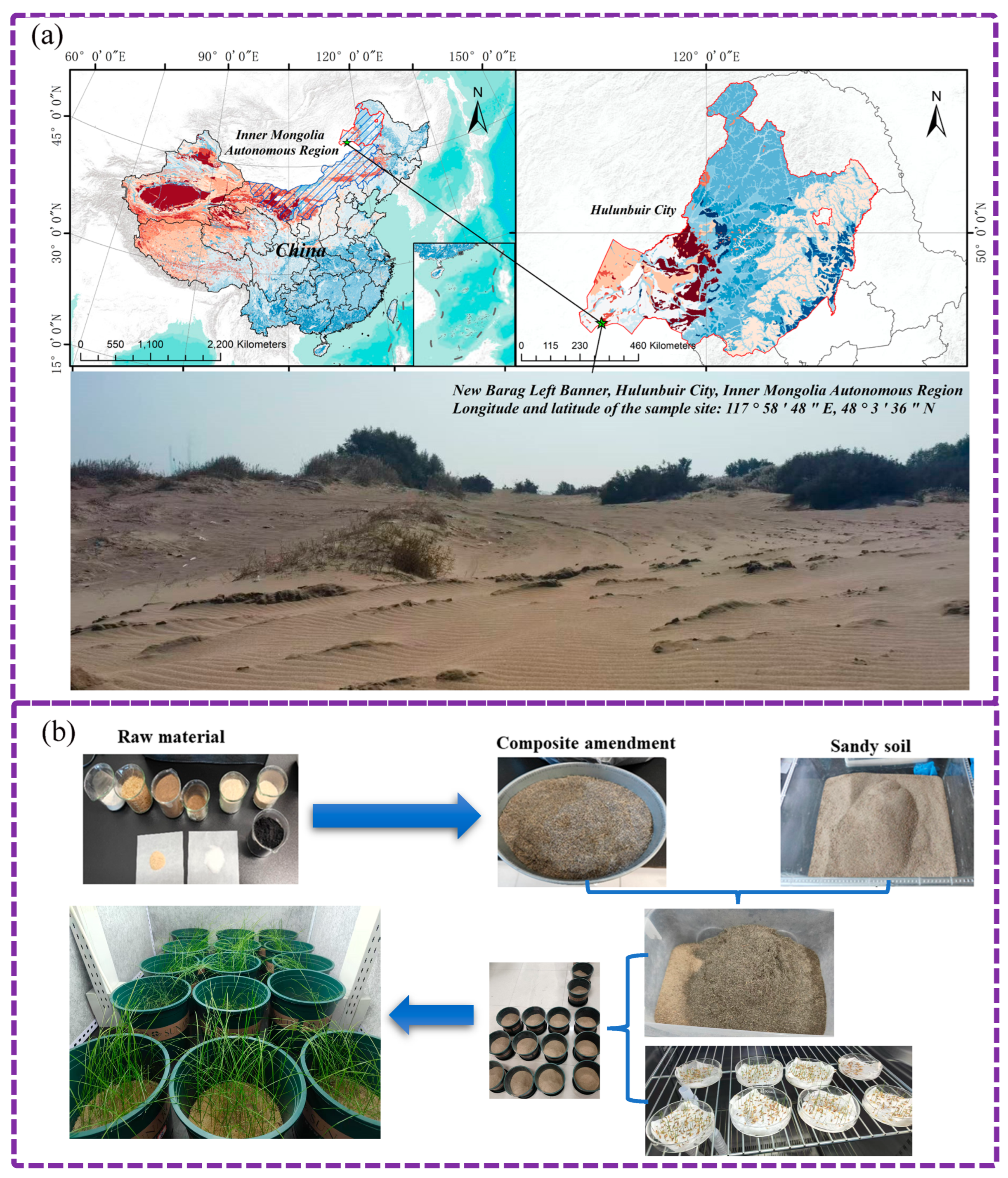
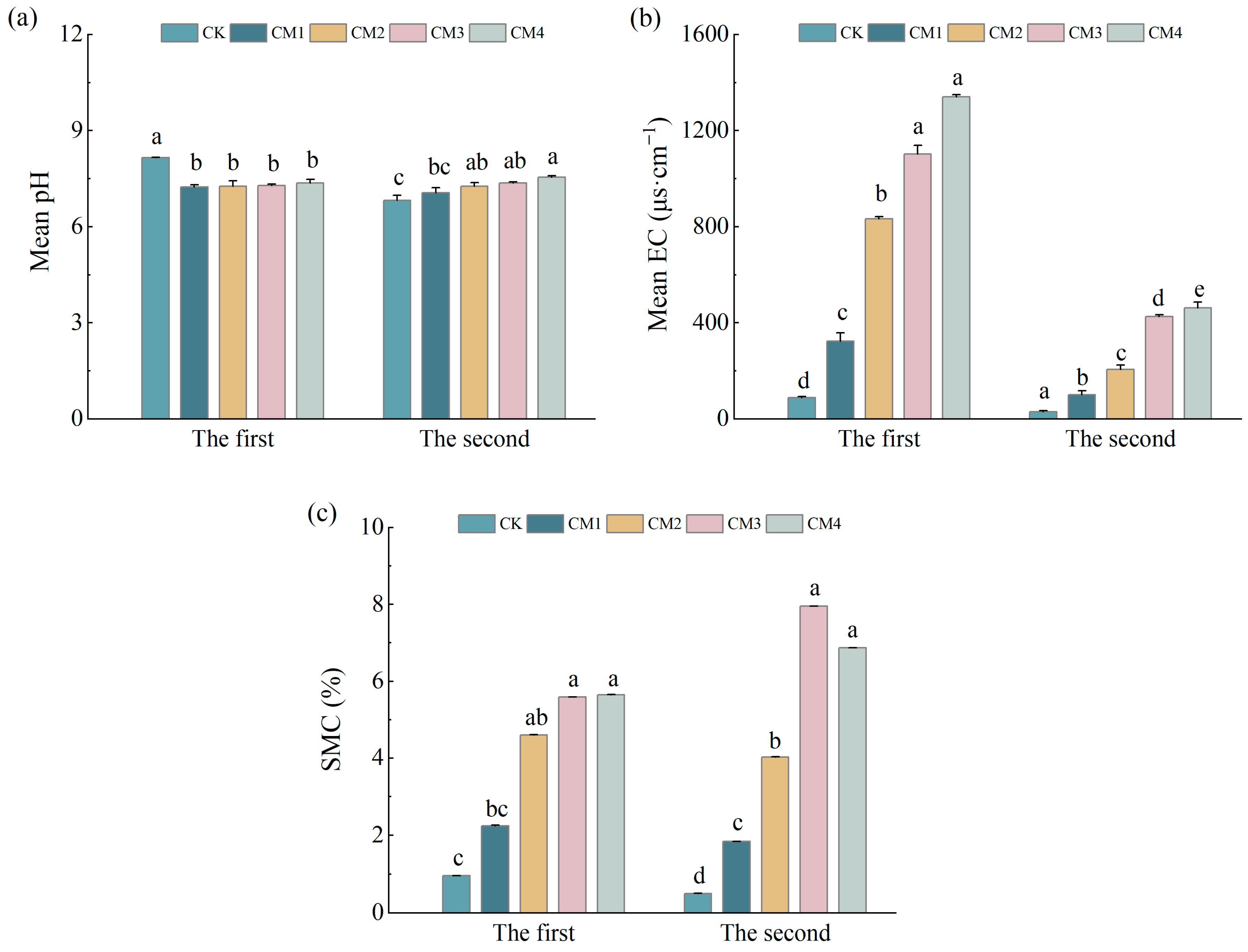
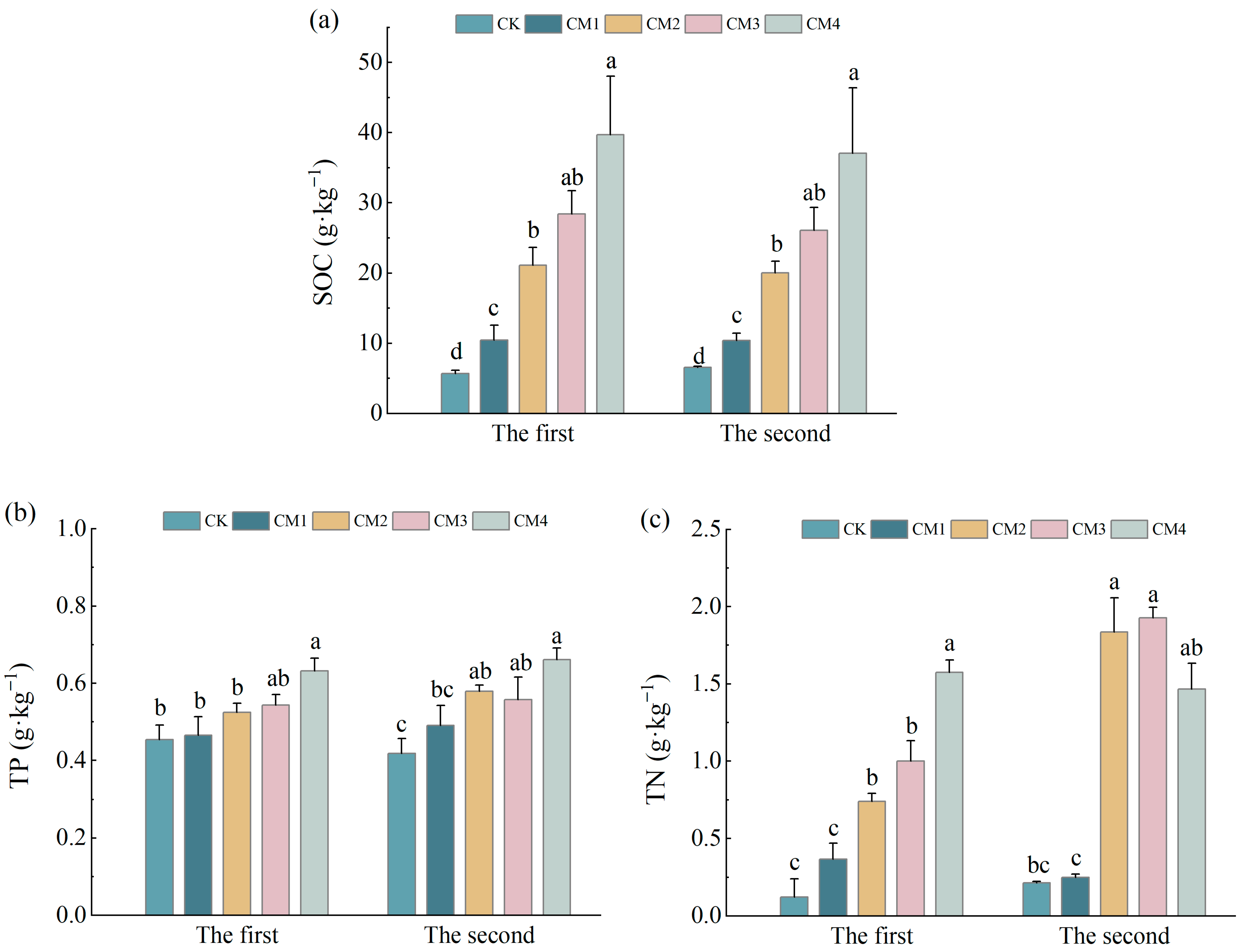
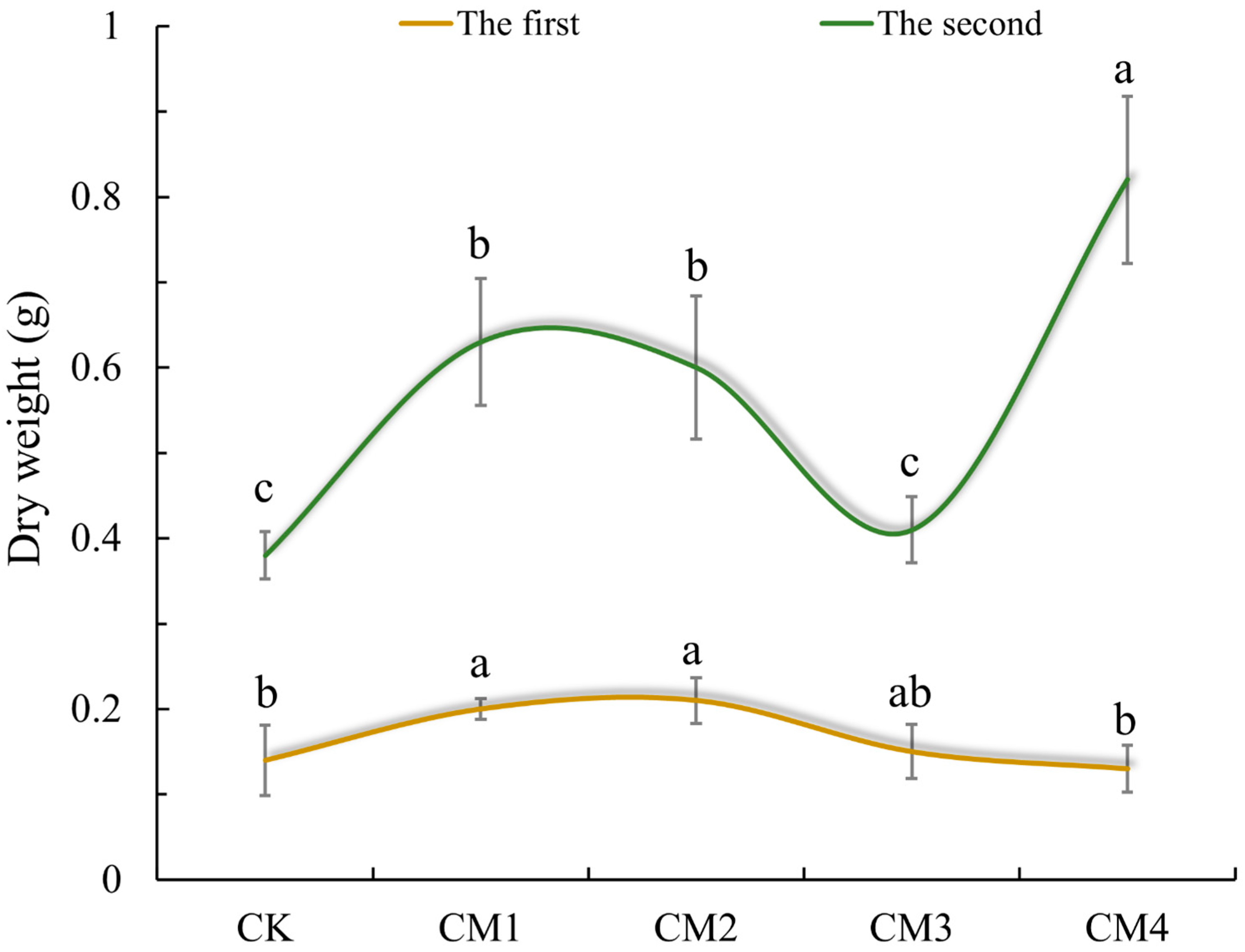
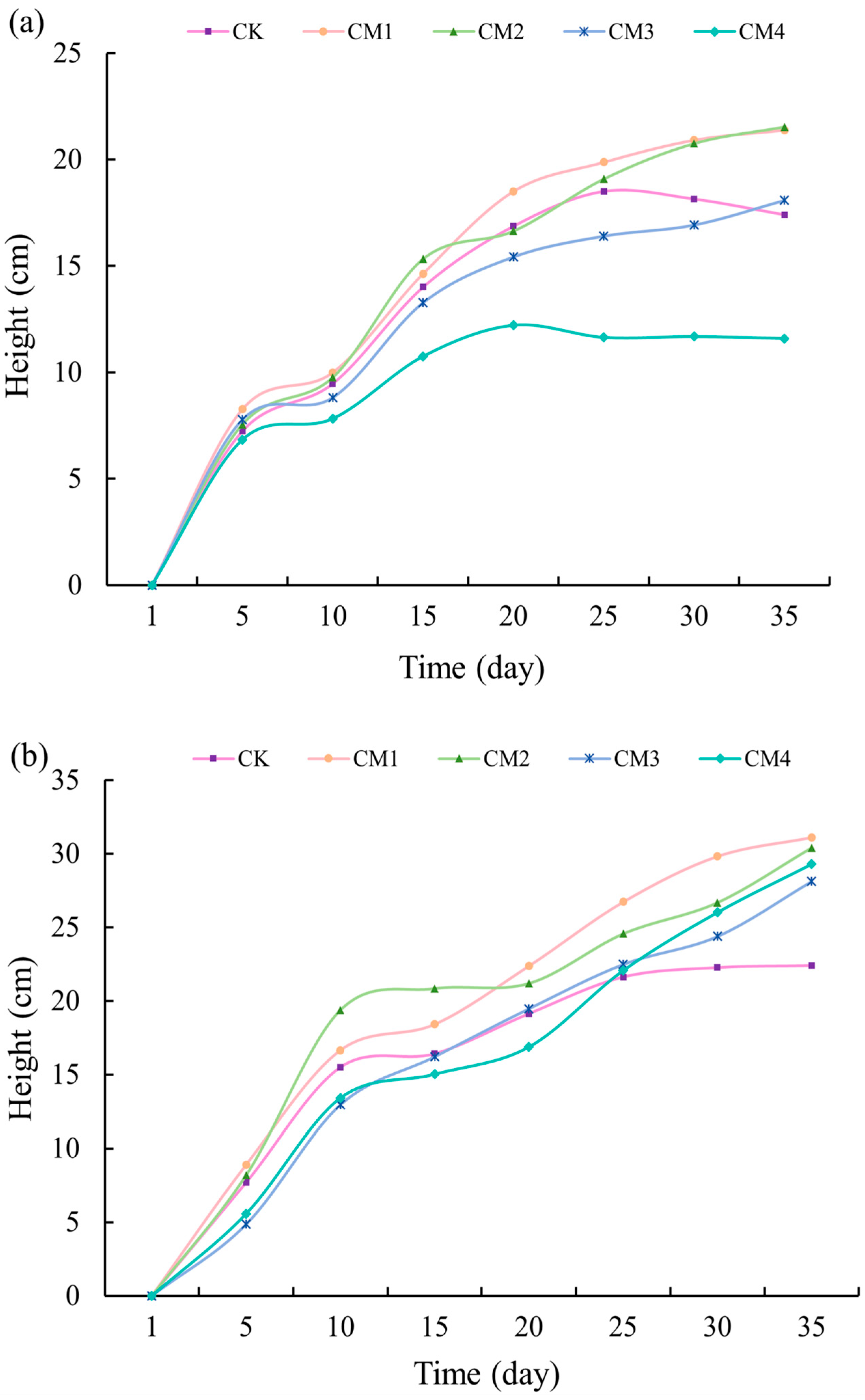
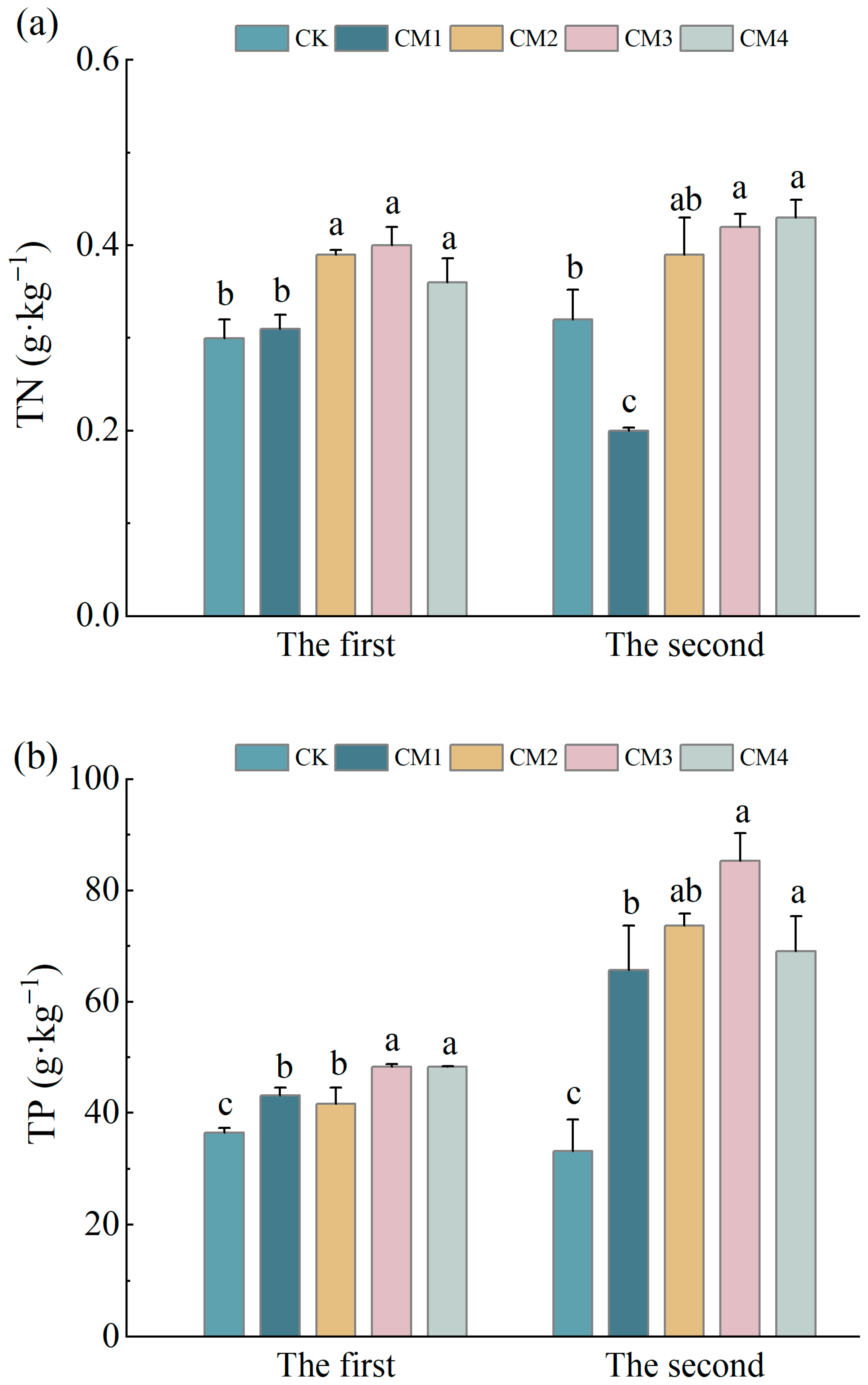
| Item | pH | EC (μs·cm−1) | SOC (g·kg−1) | TN (g·kg−1) | TP (g·kg−1) |
|---|---|---|---|---|---|
| Quantity | 8.24 ± 0.16 | 51 ± 3.36 | 6.92 ± 0.28 | 0.11 ± 0.07 | 0.24 ± 0.01 |
| Raw Material | Rate (%) | Material Properties |
|---|---|---|
| Polyacrylamide | 2.7 | Solid content > 90%, molecules number = 1.22 × 107 |
| Biochar | 16.2 | Corn straw (500 °C/2 h), pH = 9.46, OC = 42.21%, TN 8.24%, TP = 2.31%, TK = 16.12% |
| Sodium bentonite | 16.2 | Montmorillonite content > 85% |
| Straw fibers | 5.4 | Rice straw (10–20 mm) |
| Corn straw | 2.7 | Particle size < 1 mm |
| Sheep manure organic fertilizer | 54.1 | OC = 50.3%, Total nutrients (N, P, K) = 5.0%, pH = 5.5 |
| Composite microbial agents | 2.7 | Bacillus subtilis (3.03 × 1010 CFU/g), Bacillus amyloliquefaciens (2.07 × 1010 CFU/g), Gelatinous Bacillus subtilis (2.02 × 108 CFU/g), Bacillus licheniformis (1.01 × 108 CFU/g). |
Disclaimer/Publisher’s Note: The statements, opinions and data contained in all publications are solely those of the individual author(s) and contributor(s) and not of MDPI and/or the editor(s). MDPI and/or the editor(s) disclaim responsibility for any injury to people or property resulting from any ideas, methods, instructions or products referred to in the content. |
© 2025 by the authors. Licensee MDPI, Basel, Switzerland. This article is an open access article distributed under the terms and conditions of the Creative Commons Attribution (CC BY) license (https://creativecommons.org/licenses/by/4.0/).
Share and Cite
Sui, X.; Wang, L.; Lv, X.; Liu, Y.; Zhu, Y.; Fan, L.; Wang, H. Influence of Composite Amendments on the Characteristics of Sandy Soil. Sustainability 2025, 17, 7619. https://doi.org/10.3390/su17177619
Sui X, Wang L, Lv X, Liu Y, Zhu Y, Fan L, Wang H. Influence of Composite Amendments on the Characteristics of Sandy Soil. Sustainability. 2025; 17(17):7619. https://doi.org/10.3390/su17177619
Chicago/Turabian StyleSui, Xinrui, Lingyan Wang, Xinyao Lv, Yanan Liu, Yuqi Zhu, Lingyun Fan, and Hanxi Wang. 2025. "Influence of Composite Amendments on the Characteristics of Sandy Soil" Sustainability 17, no. 17: 7619. https://doi.org/10.3390/su17177619
APA StyleSui, X., Wang, L., Lv, X., Liu, Y., Zhu, Y., Fan, L., & Wang, H. (2025). Influence of Composite Amendments on the Characteristics of Sandy Soil. Sustainability, 17(17), 7619. https://doi.org/10.3390/su17177619






